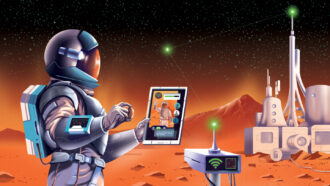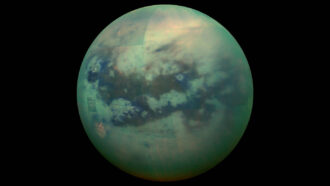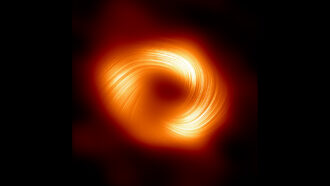Space
-
 Space
SpaceSpace tourists could face out-of-this-world health risks
As commercial spaceflight starts to take off, a new project — the Space Omics and Medical Atlas — documents potential health impacts to travelers.
By Adam Mann -
 Planets
PlanetsActive volcanoes may be common on Venus
Researchers took a new look at decades-old images from NASA’s Magellan spacecraft. These now suggest volcanic activity is widespread on the planet.
By Adam Mann -
 Physics
PhysicsForget moon walking, lunar visitors. Try horizontal running
Researchers took over the Wall of Death, an amusement park attraction, to test out how astronauts might keep their strength up on the moon.
By Meghan Rosen -
 Space
SpaceScientists Say: Astronomical interferometry
This technique links up many telescopes to see the universe in finer detail than any single telescope could alone.
-
 Space
SpaceThe shape of our universe may be complex — like a doughnut
Physicists haven’t yet ruled out the possibility that in our universe, space loops back on itself.
-
 Planets
PlanetsPluto’s heart may hide the rocky wreckage of an ancient impact
A huge, rocky remnant beneath Pluto’s surface could explain the odd location of Sputnik Planitia — its famous heart-shaped basin.
By Adam Mann -
 Space
SpaceAnalyze This: A recently spotted space object is puzzling scientists
A pulsar’s invisible partner could be an oddly heavy neutron star or a very light black hole.
By Carolyn Wilke and Adam Mann -
 Space
SpaceScientists Say: Cosmic microwave background
The cosmic microwave background is the afterglow of the Big Bang.
-
 Planets
PlanetsThe desert planet in ‘Dune’ is pretty realistic, scientists say
Humans could live on the fictional planet Arrakis from Dune. But thankfully giant sandworms probably could not.
-
 Space
SpaceHere’s how to build an internet on Mars
Future Red Planet residents will need to get online to talk to each other and Earth. But that will require a lot of new tech.
By Payal Dhar -
 Space
SpaceComets may be the source of sandy dunes on Saturn’s largest moon
In an early reshuffling of the solar system, comet collisions and other space rocks could have sent dusty bits falling to Titan’s surface.
By Nikk Ogasa -
 Space
SpaceCheck out the magnetic fields around our galaxy’s central black hole
Astronomers have captured polarized light coming from the Milky Way’s supermassive black hole. This offers insight into its magnetic fields.
By Adam Mann